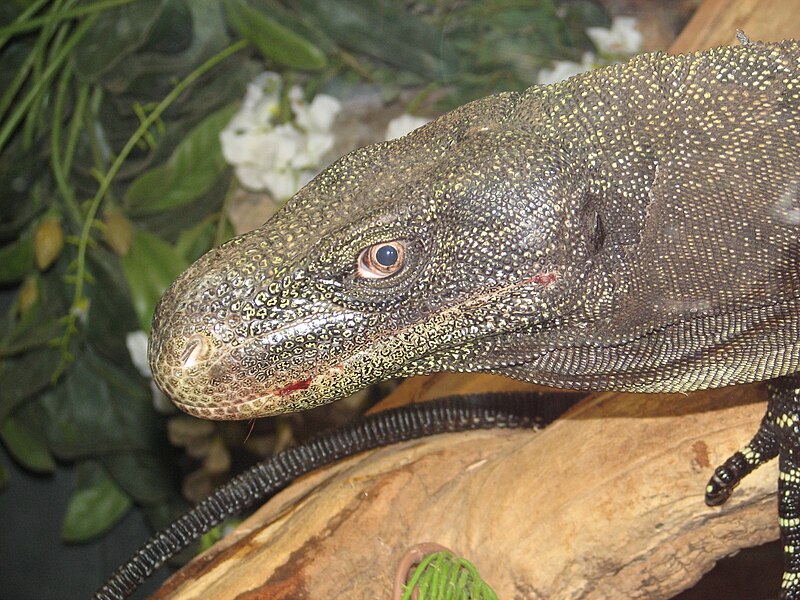Despite – or perhaps because of – its immense size, impressive armament of teeth and scarcity, the spectacular Crocodile Monitor Lizard (Varanus salvadorii) is often considered the crown jewel of private and public monitor collections.
I became acquainted with these formidable giants when they were first imported into the USA, and have cared for several at the Bronx and Staten Island Zoos. Their husbandry is straightforward, but little is known about their lives in the wild. Today I would like to summarize what we do know; please see the article referenced below for notes on captive care.
Description
 Crocodile Monitors approach 9 feet in length – nearly as long as the famed Komodo Dragon, but less stoutly built. There are recurring but unverified reports of much longer individuals.
Crocodile Monitors approach 9 feet in length – nearly as long as the famed Komodo Dragon, but less stoutly built. There are recurring but unverified reports of much longer individuals.
The Crocodile Monitor’s prehensile tail often exceeds 5 feet in length. The body is dark gray to black in color and marked with yellow spots, making for quite a spectacular appearance. The snout area, especially in mature males, is large and bulbous.
Crocodile Monitors are unusually large for canopy dwelling lizards…the 3 foot long black tree monitor is far more typical. However, aided by slender bodies, long claws and prehensile tails, they are very agile climbers.
Their teeth are unique among monitors, being serrated and over-lapping – possibly an adaptation for carrying large prey high above the forest floor.
Range and Habitat
Crocodile Monitors are found only in southern New Guinea. Highly arboreal, they seem restricted to the canopies of mangrove swamps and lowland forests along rivers.
Status
Little studied due to the inaccessibility of their habitat, the Crocodile Monitor’s limited range renders it a conservation concern. Listed on CITES Appendix II.
Reproduction
Females lay 6-12 eggs at a time, and up to 3 clutches per year in captivity (multiple clutches may be a function of food availability), with arboreal nest sites being favored. In common with other tree-dwelling monitors, they likely deposit eggs in tree hollows and similar sites above ground in the wild.
Diet
Their natural diet has been little studied, but probably includes nearly any animal that can be overpowered. Likely candidates would be cuscus, tree kangaroos, naked-tailed rats, bandicoots, possums, bats, birds, frogs, snakes, lizards, invertebrates and carrion.
An Undiscovered Giant in New Guinea?
Long a creature of legend, the Crocodile Monitor is the source of rumors alleging “Papuan Dragons” of 20 feet in length. This specie’s habitat is inaccessible and barely explored….I like to believe that it or an as yet un-described monitor may indeed reach such lengths.
A Calculating Reptile
Like all Varanids, Crocodile Monitors are highly intelligent. One huge adult that escaped its enclosure at the Bronx Zoo wedged himself behind a cage while attempting to hide from myself and a co-worker. As we moved into position to flush him, he very deliberately peered around first one and then the other side of his hideout, trying to keep us both in sight. When we backed off, he followed our progress, again changing position periodically to ascertain where we were.
The lizard remained stationary while we were near, and only ran when we gave him some space. When he did move, the old fellow made unerringly for a more secure retreat that he had obviously “decided upon” while in hiding.
Further Reading
Please see my article Monitor Lizards: an Overview for information about the captive care of this and related species.
A comprehensive field report on the crocodile monitor’s habitat is posted here.
Crocodile Monitor image referenced from wikipedia and originally posted by Ltshears
 That Reptile Blog – Reptile, Amphibian and Exotic Pet Care and Information
That Reptile Blog – Reptile, Amphibian and Exotic Pet Care and Information

 Herpetologists and hobbyists alike have long known that there is something “different” about the family of lizards known collectively as “monitors” (or, in Australia, “goannas”). One cannot observe a monitor for long without getting a sense of the animal’s intelligence – they scrutinize the world differently than do other reptiles, and their reactions to new situations are surprisingly quick and complex. Recent studies have confirmed that monitors are unique, and, in many ways, the most intelligent and advanced of the lizards.
Herpetologists and hobbyists alike have long known that there is something “different” about the family of lizards known collectively as “monitors” (or, in Australia, “goannas”). One cannot observe a monitor for long without getting a sense of the animal’s intelligence – they scrutinize the world differently than do other reptiles, and their reactions to new situations are surprisingly quick and complex. Recent studies have confirmed that monitors are unique, and, in many ways, the most intelligent and advanced of the lizards. All monitors share a similar body plan – a long neck and relatively small head, sturdy body and limbs and a long, powerful tail, and most measure in the range of 2 to 5 feet in length.
All monitors share a similar body plan – a long neck and relatively small head, sturdy body and limbs and a long, powerful tail, and most measure in the range of 2 to 5 feet in length.